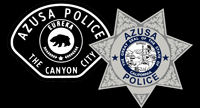Our History
From patrolling in tan and green uniforms to a one-man detective bureau, the department began to take shape.
The Early Years
During the 1920's, the police station was located in city hall, on the west side of Alameda Avenue in the 700 block. In 1934, during the height of the depression, Sam Bierbower was appointed Chief of Police. His department boasted two patrol cars, one of which was a distinctive all-white Ford Model A Touring Car. Chief Bierbower had the officers wear tan and green uniforms.
In 1935, the department got one-way radios for its cars. There was only a receiving unit in the car and the calls were dispatched from the Pomona Police Department, 10 miles away. By this time, City Hall was on the east side of Alameda Avenue in the building now referred to as the "West Wing," and it included both the Police and Fire Departments.
Harry Chester was the Chief of Police from 1937 to 1938. Little is known about Chief Chester's tenure, but it is said that he had no police experience and simply held the department together until a permanent chief could be hired.
The 1940s
Fred Williams was appointed to chief in 1938, after having started with the department in the early 1930s. He joined as a full-time officer in 1934 when there were only four officers on the force. Chief Williams introduced two-way radios in 1944, which, at the time, was a significant technological advancement.
From 1944 to 1949, Chief Milo Hawkins commanded the department, when one of the major concerns was traffic in the City. The now historic Route 66 (Foothill / Alosta corridor) was heavily traveled, especially on weekends.
The 1950s and 1960s
Chief Al Kenderick was promoted to chief from the rank of patrolman in 1949 and held that position until 1968. He received his training while working as a Los Angeles County Deputy Sheriff and through intense personal study.
The first real growth of the department was seen under Kendrick's leadership. Chief Kenderick started a one-man detective bureau in 1949. The next year brought in a teletype machine so Azusa could communicate with other police agencies.
In 1958 he instituted a Reserve Police Officer Unit to supplement manpower needs. By 1963 there were five black and white police cars, four detective cars, three motorcycles, and one jeep.
The first known Azusa Police Department Annual Report was prepared in 1956. The most notable points of that report were:
- The department consisted of the chief, one captain, one lieutenant, five sergeants, 17 patrolmen, one policewoman, and two motor officers
- The top salary for a police officer was $497 a month.
- There were zero homicides, nine robberies, 28 aggravated assaults, and 155 burglaries
- There was a total of 567 arrests that year.
The 1970s and 1980s
In 1968, Chief Carl Elkins was promoted from Lieutenant to Chief of Police. He led the department through the late 1960s and the 1970s which were challenging times for our society and its police forces, due to a controversy over the war in Vietnam, and the social unrest over concerns such as racial equality and diversity in the workplace. The department moved in 1970 into what its most recent former headquarters at 725 N. Alameda Avenue.
Chief Lloyd Wood was a captain with the El Monte Police Department when he was hired by the City of Azusa in 1981.
Chief Wood's major focus was on crime prevention. In working closely with the community, he created the School Resource Officer position, which placed a police officer on the Azusa High School campus on a full-time basis. He reinstated the motorcycle officer program, which had been idle for several years. He also created the department's first canine officer position and started a Special Weapons and Tactics Team ("SWAT").

